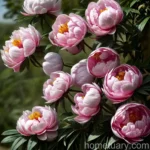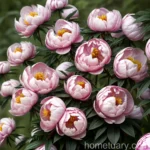Plant Scientist’s Guide to the Yellow Doodle Dandy Peony
Welcome to the ultimate guide to the Yellow Doodle Dandy peony (Paeonia ‘Yellow Doodle Dandy’). As a plant scientist, I am thrilled to take you on a fascinating journey into the world of this stunning peony variety. We will explore its characteristics, growth requirements, uses, and much more. Whether you are a seasoned gardener or a novice plant enthusiast, this comprehensive guide will equip you with the knowledge and skills to cultivate and appreciate this beautiful plant to the fullest.
What is the Yellow Doodle Dandy Peony (Paeonia ‘Yellow Doodle Dandy’)?
The Yellow Doodle Dandy peony, scientifically known as Paeonia ‘Yellow Doodle Dandy’, is a captivating perennial plant cherished for its radiant blooms and graceful appearance. This delightful peony variety is beloved by gardeners and horticulturists for its vibrant yellow flowers and lush, dark green foliage. With its alluring fragrance and striking aesthetic appeal, the Yellow Doodle Dandy peony has secured its place as a cherished gem in gardens and landscapes.
Key Takeaways – Yellow Doodle Dandy Peony
Before delving into the specifics of cultivating and caring for the Yellow Doodle Dandy peony, let’s highlight some key takeaways about this enchanting plant:
- The Yellow Doodle Dandy peony, or Paeonia ‘Yellow Doodle Dandy’, is renowned for its stunning yellow blooms that add a touch of elegance and vibrancy to any garden or landscape.
- This peony variety requires diligent care and attention to thrive, making it a rewarding choice for experienced gardeners seeking a delightful challenge.
- The Yellow Doodle Dandy peony’s cultural significance, uses, and aesthetic allure contribute to its widespread popularity among plant enthusiasts and horticultural professionals.
Now, let’s embark on a comprehensive exploration of the Yellow Doodle Dandy peony, covering its culture, uses, growth requirements, maintenance, and much more.
Culture
Water
One of the essential factors in fostering the optimal growth and vibrancy of the Yellow Doodle Dandy peony is ensuring adequate water supply. While these resilient plants can endure periods of moderate drought, providing consistent moisture is crucial, particularly during the blooming season and hot, dry spells.
To maintain an ideal moisture balance for the Yellow Doodle Dandy peony:
- Watering Schedule: During the growing season, aim to water the peony deeply once a week, ensuring that the soil is moist but not waterlogged. Adjust the frequency based on specific weather conditions and soil moisture levels.
- Mulching: Applying a layer of organic mulch around the base of the plant can help regulate soil moisture, suppress weed growth, and protect the peony’s roots from temperature fluctuations. Mulch also contributes to the overall health and vigor of the plant.
Sunlight
Adequate sunlight is crucial for the Yellow Doodle Dandy peony’s overall health, blooming potential, and robust growth. When selecting a location for planting or transplanting the peony, consider the following sunlight requirements:
- Full Sun: The Yellow Doodle Dandy peony thrives in locations with full sun exposure, receiving at least 6-8 hours of direct sunlight daily. Choose a site with ample sunlight and well-drained soil to promote healthy foliage and prolific blooming.
Fertilizer
Implementing a strategic fertilization regimen is instrumental in nurturing the Yellow Doodle Dandy peony and enhancing its growth and flowering capabilities. As the plant scientist responsible for maximizing the peony’s potential, consider the following fertilization guidelines:
- Timing: Apply a balanced, slow-release fertilizer in early spring, as new growth emerges. Avoid over-fertilizing, as excessive nutrients can compromise the plant’s overall health and natural growing cycle.
- Fertilizer Type: Select a fertilizer specifically formulated for flowering perennials or peonies. A balanced NPK (nitrogen, phosphorus, potassium) formulation, such as 10-10-10, can provide the essential nutrients for robust growth and vibrant blooms.
Soil
The soil composition and quality play a pivotal role in the Yellow Doodle Dandy peony’s vitality and overall well-being. When selecting a planting site or preparing the soil for a container, prioritize the following soil preferences:
- Well-Drained Soil: The Yellow Doodle Dandy peony thrives in well-drained, loamy soil with a neutral to slightly acidic pH. Avoid waterlogged or compacted soil, as it can lead to root rot and hinder the plant’s development.
- Soil Amendment: Incorporating organic matter, such as compost or well-rotted manure, into the soil can enhance its structure, fertility, and moisture retention capabilities. Prior to planting, amend the soil to create an optimal growing environment for the peony.
Pruning
Pruning is a fundamental aspect of maintaining the Yellow Doodle Dandy peony’s health, promoting robust blooming, and shaping its overall appearance. As a plant scientist dedicated to optimizing the plant’s potential, consider the following pruning guidelines:
- Pruning Timing: After the peony completes its blooming cycle, typically in late spring or early summer, prune the spent flowers and any damaged or diseased foliage. Additionally, conduct a more comprehensive pruning session in late autumn or early winter, once the plant becomes dormant.
- Pruning Techniques: Use clean, sharp pruners to remove the faded blooms just below the flower head. Trim back any discolored or withered foliage to maintain the plant’s vitality and aesthetics while minimizing the risk of disease.
Propagation
The propagation of the Yellow Doodle Dandy peony involves various techniques, including division and root cuttings, to preserve and expand the plant’s presence in gardens and landscapes. As a plant scientist devoted to perpetuating the beauty and legacy of this remarkable peony, explore the following propagation methods:
- Division: Dividing mature peony clumps every 3-4 years in late summer or early autumn can rejuvenate the plant, enhance its vigor, and yield new growth. Carefully separate the roots and crown, ensuring that each division contains healthy buds and root structures for optimal success.
- Root Cuttings: While less commonly practiced, propagating the Yellow Doodle Dandy peony from root cuttings can be a viable method for generating new plants. Select healthy, thick roots and cut them into sections, ensuring that each cutting contains viable buds or growth points. Plant the root cuttings in a well-draining growing medium and provide the necessary care for successful establishment.
Container Popularity
The Yellow Doodle Dandy peony’s allure extends to container gardening, offering a versatile and captivating option for adorning balconies, patios, and small outdoor spaces. As a plant scientist advocating for the implementation of diverse gardening methods, celebrate the peony’s container popularity through the following insights:
- Container Selection: Choose a spacious, well-draining container with adequate drainage holes to accommodate the peony’s root system and promote healthy growth. Select a container with a diameter of at least 18 inches to allow ample space for the plant to flourish.
- Soil and Watering: Use a high-quality, well-draining potting mix designed for flowering perennials when planting the Yellow Doodle Dandy peony in a container. Monitor the soil moisture levels closely, ensuring consistent watering while avoiding waterlogged conditions.
- Sunlight Exposure: Position the container in a location that receives ample sunlight, ideally 6-8 hours of direct sunlight per day, to support the peony’s photosynthetic processes and overall vitality.
Common Diseases
Disease Diagnosis
As a vigilant plant scientist committed to safeguarding the Yellow Doodle Dandy peony’s health and longevity, familiarize yourself with common diseases that may affect the plant. When diagnosing and addressing potential diseases, be attentive to the following symptoms and indicators:
- Botrytis Blight: Recognized by the presence of gray mold on the flowers, stems, or foliage, botrytis blight typically occurs in humid or wet conditions. Implement proper air circulation, promote soil drainage, and remove affected plant tissues to mitigate the spread of the disease.
- Powdery Mildew: Manifesting as a white, powdery coating on the foliage, powdery mildew can compromise the peony’s aesthetics and vigor. Monitor humidity levels, maintain adequate spacing between plants, and apply fungicidal treatments as necessary to manage powdery mildew.
Common Pests
The Yellow Doodle Dandy peony is susceptible to certain pests that can compromise its growth and flowering potential. As a vigilant plant scientist, it is crucial to identify and address common pests to safeguard the plant’s well-being. Keep a watchful eye for the following potential pests:
- Red Spider Mites: These tiny arachnids can infest the peony’s foliage, sucking plant juices and causing stippling or discoloration. Regularly inspect the undersides of the leaves for mite activity and implement appropriate miticidal treatments to mitigate infestations.
- Peony Lice (Aphis spp.): Aphids can feed on the plant’s sap, leading to distorted growth, yellowing foliage, and the secretion of sticky honeydew. Employ targeted insecticidal treatments or introduce natural predators, such as ladybugs, to manage aphid populations and protect the peony.
Botanist’s Tips
As a seasoned plant scientist with a profound appreciation for the Yellow Doodle Dandy peony, I offer the following invaluable tips to elevate your cultivation and care practices:
- Mulch Mindfully: When applying mulch around the peony, ensure that the material does not come into direct contact with the plant’s stems or crown, as this can promote moisture retention and potentially lead to rot or fungal issues. Maintain an appropriate distance between the mulch and the plant to safeguard its health.
- Adequate Air Circulation: Promote good air circulation around the peony by spacing plants appropriately and avoiding overcrowding. Ample airflow can reduce the risk of fungal diseases and enhance the plant’s overall resilience.
Fun Facts
To truly appreciate the Yellow Doodle Dandy peony and its captivating presence in the natural world, consider the following fun facts about this remarkable plant:
- Symbolism: In various cultures and traditions, peonies are associated with prosperity, romance, and good fortune, infusing the Yellow Doodle Dandy peony with rich symbolic significance.
- Fragrance: Some varieties of peonies, including the Yellow Doodle Dandy, exude a delightful, sweet fragrance, making them not only visually appealing but also sensorially captivating.
- Historical Significance: Peonies have a storied history, tracing back to ancient civilizations such as China, where they were revered for their beauty and medicinal properties.
Links to External Resources
To further enhance your knowledge and appreciation of the Yellow Doodle Dandy peony, explore the following external resources for valuable insights and inspiration:
- Royal Horticultural Society (RHS): Access comprehensive information on the cultural significance, care requirements, and captivating features of the Yellow Doodle Dandy peony from the Royal Horticultural Society.
- American Peony Society: Delve into the world of peonies and join a community of enthusiasts and experts through the American Peony Society’s wealth of resources, events, and publications.
By immersing yourself in these valuable external resources, you can expand your understanding and appreciation of the Yellow Doodle Dandy peony, gaining essential knowledge to elevate your gardening pursuits.
In conclusion, the Yellow Doodle Dandy peony (Paeonia ‘Yellow Doodle Dandy’) stands as a radiant testament to nature’s beauty and resilience, captivating hearts and gardens worldwide. As a devoted plant scientist, it brings me immense joy to share this comprehensive guide, empowering you to nurture, admire, and celebrate the remarkable allure of this extraordinary peony variety.
Embrace the journey of cultivating and cherishing the Yellow Doodle Dandy peony, and may its vibrant blooms and timeless charm enrich your life and garden in boundless ways.















